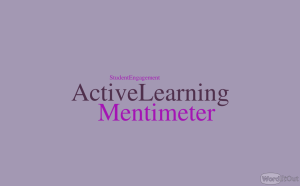As the day wears on, it’s not uncommon to see learners becoming unfocused, disengaged with classroom tasks, restless, noisy or silent. The most demotivating aspect of disinterested students is their unwillingness to learn. A Gallup student poll (2014) reports that nearly 50% of the learners were “either not engaged (28 percent) or actively disengaged (19 percent) in school” (Collier, 2015).
Tag Archives: engage
AI in ESL: Empowering Learners and Bridging Language Gaps
By Margaret Holec
Introduction
The past decade has seen a game-changing impact on English as a Second Language (ESL) education, thanks to Artificial Intelligence (AI). Notably, AI has made students more independent in their learning, helping them secure jobs even with lower English levels. Additionally, direct translation of messages and emails has become seamless, enhancing communication.
1. Independent Learning: AI’s Role in Student Empowerment
AI in ESL education has shifted the focus to personalized learning, allowing students to learn at their own pace. This independence builds confidence and self-reliance as learners navigate language acquisition with tailored support.
Continue readingCreating Effective Lesson Plans
It is often said that if you fail to plan, you plan to fail. One of the challenges cited by teachers in the language classroom especially is creating effective lesson plans (Velikaya, 2020).
So, what is an effective lesson plan?
Continue readingUsing Authentic Materials for EAP Students
 Have you ever considered how you might conduct effective and enjoyable EAP sessions? Despite the limited duration and high-stakes nature of EAP classes, the emphasis on learner autonomy, critical thinking, and authentic academic situations renders the teaching process potentially more engaging than that of a standard English course, provided appropriate delivery methods are employed.
Have you ever considered how you might conduct effective and enjoyable EAP sessions? Despite the limited duration and high-stakes nature of EAP classes, the emphasis on learner autonomy, critical thinking, and authentic academic situations renders the teaching process potentially more engaging than that of a standard English course, provided appropriate delivery methods are employed.
As per Tomlinson’s (2013) perspective, classroom material ought to offer an array of authentic input in the target language, encompassing diverse styles, forms and functions. Based on this notion, I developed a lesson plan aimed at introducing my EAP students to academic research reports, facilitating their exposure to an authentic lecture and enabling them to independently explore the subject matter. To achieve this objective, I selected a TED talk and a pertinent research article as the primary resources for this lesson. Continue reading
Active Learning With Mentimeter
 “Active learning engages students in the process of learning through activities and/or discussion in class, as opposed to passively listening to an expert” (Freeman et al., 2014).
“Active learning engages students in the process of learning through activities and/or discussion in class, as opposed to passively listening to an expert” (Freeman et al., 2014).
One tool that has made active learning more possible in my classes is Mentimeter.
Whether we teach a class in person or we teach an online synchronous course, Mentimeter can accommodate engaging large groups of audiences. If we teach a class implementing Bloom’s Taxonomy approach, Mentimeter can be a great tool in developing a successful and engaging lesson. Continue reading
Throwback Thursday
While I am sure most instructors have begun classes for the fall term, perhaps you have new students trickling in – or haven’t had a chance to do a “get-to-know-you activity. Follow the link below to read Cecilia’s ideas from her October 2014 post.
http://blog.teslontario.org/get-to-know-activities-in-the-language-classroom/
Creating Dialogues Remotely
Over the pandemic, several instructors have commonly requested assistance with recording dialogues for PBLA activities, assessments, reading practice or listening activities. In this post, I have detailed the steps. These steps focus on preparing a listening dialogue for a class activity. I am sure that many instructors and students have devised their own hacks for this issue, so if you have invented better methods, please add them to the comments below.
Continue readingSAMR Says, Part II

SAMR Says
Change is never comfortable, but, as we all know, it is necessary. The SAMR model is flexible and easy to use at all levels of education. To read about ‘Substitution’ and ‘Augmentation,’ please check out SAMR Says, Part I, where we discussed these stages of ‘Enhancement’ and some simple and fast tools you can find to help you move from paper to online without much stress or extra work. Using technology tools that enhance your class, as per the SAMR model, means that you are enhancing yourself, the material, and the students’ experience too.
In this blog, we will be discussing the stages of ‘Transformation’ and how to modify and redefine your approach to allow for more technology in your class.
Continue reading#CdnELTchat: join the chat on Tuesday!
 If you’re a Twitter user, join the next #CdnELTchat usually every second Tuesday. Below is a recap of the November 27th chat from the #CdnELTchat moderators.
If you’re a Twitter user, join the next #CdnELTchat usually every second Tuesday. Below is a recap of the November 27th chat from the #CdnELTchat moderators.
I have been learning how to speak Mandarin for the better part of twenty years, but I still can’t produce the fourth tone correctly. I automatically say the first tone instead of the fourth tone in conversation. I am aware that I do this, yet I can’t seem to correct this bad habit. Is this a fossilized error? Is there anything I can do to overcome this error? On November 27th, a group of educators discussed these questions and more on #CdnELTchat.
Thank-you so much to the enthusiastic participants who contributed their ideas and shared resources during this chat. Continue reading
Join the conversation November 6th on #CdnELTchat
If you’re a Twitter user, read on to learn all about how you can join the next #CdnELTchat which takes place tomorrow, November 6th. Below is a recap of last month’s chat from the #CdnELTchat moderators.
In our personal lives, we use YouTube playlists, Facebook feeds, pins on Pinterest, Instagram feeds, saved tweets on Twitter etc. to save and share videos, news, images and information. With the increase of accessible information and resources online, what can educators and students do to curate content effectively? Bonnie Jean Nicholas (@EALStories) and Jennifer Chow (@jennifermchow) moderated a #CdnELTchat on “Content Curation” to explore this topic.






